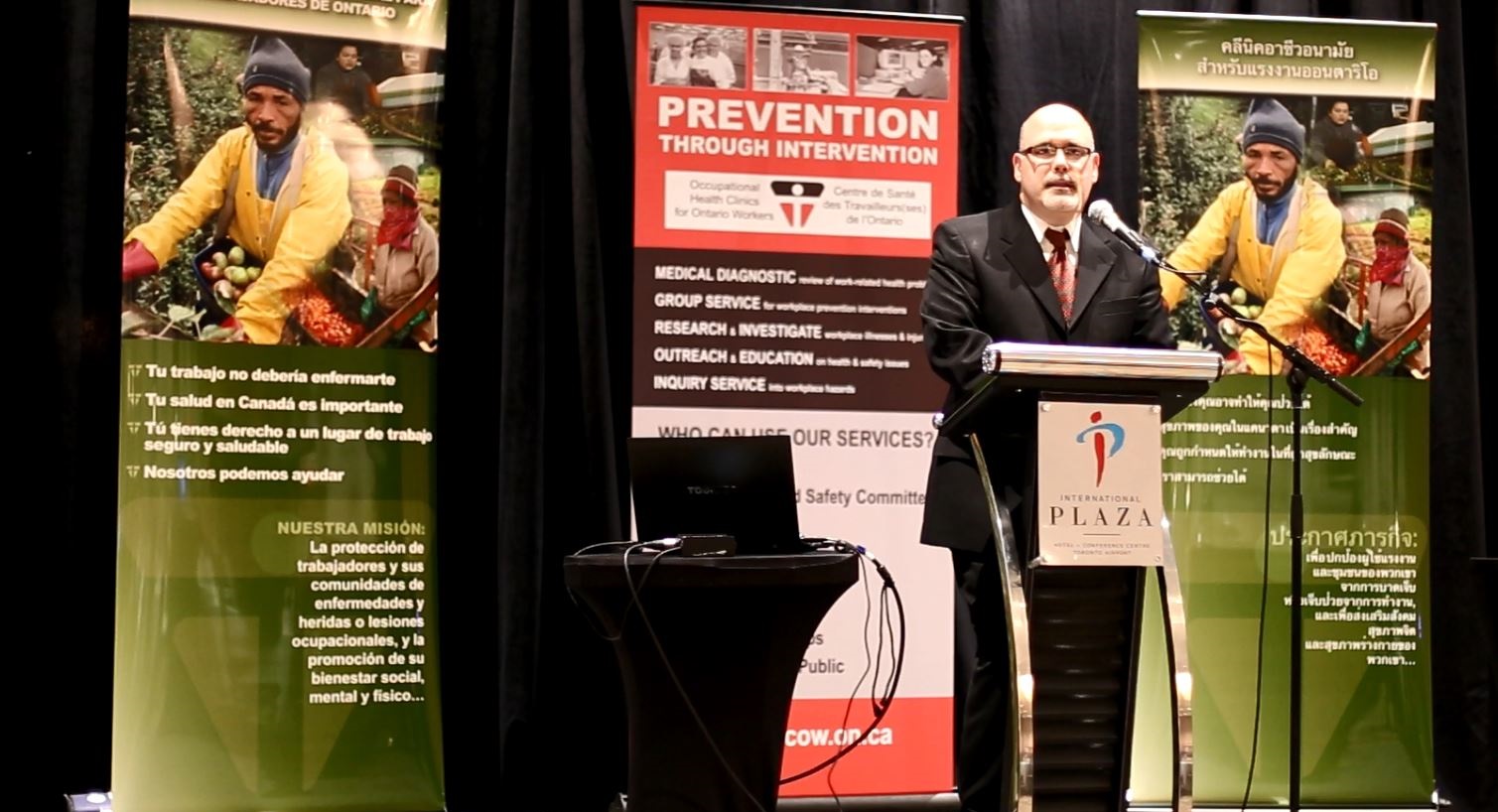Celebrating the Past and Looking Forward - 25 Years of OHCOW
OHCOW celebrated 25 years of providing services to Ontario Workers with a special anniversary conference held on October 30th and 31st, 2014 in Toronto. Thank you to all of the presenters, speakers and participants in making this event a huge success.
More than 200 people attended the 25th anniversary conference that kicked off with significant key note addresses, a presentation on OHCOW history and past achievements followed by a series of interactive and informative workshop sessions relating to Clinical, Hygiene, Ergonomic, Psycho Social Hazards, and New Prevention tools.
- Key note addresses
- "Celebrating the Past" - Video presentation on OHCOW history and past achievements
- Presentations
- Mental Injury Tool (MIT) - John Oudyk, Occupational Hygienist, OHCOW Hamilton Clinic
The Mental Injury Tool Group is an excellent example of worker representatives and OHCOW working together to address a very important issue for workers – workplace stress. Together we have created a set of tools for worker representatives to measure stress. During this presentation OHCOW officially launched a new smart phone App that lets you answer the questionnaire and measure your level of stress. Visit our MIT page to learn more. - Causation of Chronic Diseases Including Cancer - Dr. Noel Kerin, OHCOW Medical Consultant
Discuss the future contribution of OHCOW to the scientific understanding and prevention of the occupational & environmental causes of diseases. - Guidelines For The Prevention Of Back Injuries Among EMS Workers - Trevor Schell, Ergonomist, OHCOW Sudbury Clinic, Andréane Chénier, CUPE, National Representative - Health and Safety
Back injuries are the #1 problem facing paramedics. Discover how a proactive partnership between OHCOW, CUPE and the employer led to the development of a guideline for preventative strategies that can be used on a daily basis. - Service to Migrant Farm Workers (MFWs) - Michelle Tew, Occupational Health Nurse, OHCOW Hamilton Clinic
This session highlighted OHCOW’s experiences in developing and delivering services which are directed at the 20,000 migrant farm workers who come to Ontario every year. - Intake Clinics - Donna Campbell, Executive Director, OHCOW Sudbury Clinic; Leslie Piekarz, Executive Director, OHCOW Toronto Clinic; Andy LaDouceur, United Steel Workers (USW)
Intake clinics have proven to be a powerful and focused strategy that links historic and current health conditions to workplace exposures. This session provided sample results from data obtained and demonstrated how it can assist with compensation and prevention strategies. - Labour OHCOW Academic Research Collaboration (LOARC) - Terri Aversa, OPSEU Health and Safety Officer
The goal of LOARC is to improve working conditions and health for workers through fostering research collaboration across unions, occupational health and safety professionals and university researchers. This session reported on two recent studies that LOARC had undertaken:
- LOARC Paper—Internal Responsibility: The Challenge and the Crisis—a paper that identifies areas for reform to improve internal responsibility in Ontario’s health and safety system.
- Health and safety representative study: Making participation work in the new economy—a study of health and safety representatives in Ontario to identify what type of activities and styles bring the most success.Learn more
- Physical Demands Description (PDD) - Curtis VanderGriendt, Ergonomist, OHCOW Hamilton Clinic , Brendan Coffey, Ergonomist, OHCOW Windsor Clinic
In a collaborative partnership with Queen’s University, our new Physical Demands Description (PDD) Handbook highlights the process, considerations and techniques to accurately document the physical demands of each job within a workplace. It provides workplace parties with a PDD template that can be used in a wide range of settings. While it is not intended to be a standalone, detailed blueprint, the handbook can be used as a guidance document to be combined with additional training or education using the handbook itself as a training resource. - NOISE - Its Effects and Methods to Reduce Exposure - James Miuccio, Occupational Hygienist, OHCOW Windsor Clinic
Repetitive exposure to noise can result in noise-induced hearing loss, physiological conditions and performance-related effects. This session assists with the understanding and identification of the health effects that result from exposure to noise and methods that may be utilized to reduce and prevent exposure. - Office Ergonomics - Trevor Schell, Ergonomist, OHCOW Sudbury Clinic; Dwayne Fuchs, Ergonomist, OHCOW Thunder Bay Clinic
The OHCOW Office Ergonomics Handbook is intended to guide you in a self-assessment of the ergonomic design of your computer workstation. This session focuses on helpful tips on how to identify and correct ergonomic problems to prevent repetitive strain injury, eyestrain, fatigue and discomfort. A checklist tool was developed in partnership between OHCOW and a workplace party in order to identify hazards for musculoskeletal disorders (MSD). Delegates will have an opportunity to learn how to use the checklist for their own workplaces to identify issues for prevention. (Check out other related resources from this session - Exercises at Your Workstation and, Office Ergonomics Checklist Setting Up the Computer Workstation to Fit You, - Doing Something About Heat Stress - John Oudyk, Occupational Hygienist, OHCOW Hamilton Clinic
Learn about the health effects of heat stress and what can be done to prevent it. Measuring heat stress can be very complicated and expensive, however, OHCOW has worked with unions to create a simple tool to manage heat stress. By translating the Wet Bulb Globe Temperature (WBGT which the MOL references) into Humidex, the OHCOW plan makes it easy to determine when it’s just too hot to work. - Practical Ergonomic Interventions - Trevor Schell, Ergonomist, OHCOW Sudbury Clinic
One of the major hurdles for workplaces that are struggling to implement ergonomic prevention interventions in the workplace is the belief that the changes will be too costly. However, this is not true the majority of the time. This session will focus on cost effective solutions other workplaces have successfully implemented in a wide variety of industries. The participants can take these proven solutions and apply them to their own workplace situations. - MSD Survey Tool - Curtis VanderGriendt, Ergonomist, OHCOW Hamilton Clinic
The OHCOW MSD Survey tool allows workplaces to identify trends in pain and discomfort among workers. Workplaces can distribute a survey to all workers or groups of workers and analyze the results using the tool. Once the survey responses have been entered, the tool immediately displays colour-coded results. This can be very helpful to assist in identifying trends and problem areas in the workplace that may require ergonomic improvements. (Check out other related resources from this session - MSD Symptom Exposure Survey , MSD Survey Analysis Tool, and Instructions) - Backcare Lifting Techniques - Andre Gauvin, Ergonomist, OHCOW Sudbury Clinic
Back problems are one of the main injuries identified by WSIB. This session will help you better understand the anatomy of the back, injury risk factors, and provide sound prevention strategies to reduce the risk of back injuries. - 3d Static Strength Prediction Program And How OHCOW Utilizes it - Trevor Schell, and Andre Gauvin , Ergonomist, OHCOW Sudbury Clinic
The 3D SSPP software predicts static strength requirements for tasks such as lifts, presses, pushes, and pulls. OHCOW will demonstrate how it uses this software for both preventative as well as clinical projects. - Quick Exposure Check (QEC) - Curtis VanderGriendt, Ergonomist, OHCOW Hamilton Clinic and Brenda Mallat, Ergonomists, OHCOW Hamilton Clinic
The Quick Exposure Check (QEC) Excel tool developed by OHCOW was designed to create an efficient and organized way to complete QEC assessments. The tool allows users to document tasks of different jobs and identify the resulting exposure levels. The tool will particularly be helpful to workplaces who implement solutions to address the identified hazards. Users are able to document before and after scenarios and compare the exposure levels to ensure that the intended reduction in exposure levels has occurred. (Check out other related resources from this session - QEC Calculation Tool, additional information on using the tool) - Doing Something about Indoor Air Quality (IAQ) - John Oudyk, Occupational Hygienist, OHCOW Hamilton Clinic
Sick Building Syndrome is a common problem in offices, retail, hospitality and even healthcare facilities. However, standard measurements often do not identify any problem despite worker symptoms. For more than 20 years, OHCOW has been using a standardized questionnaire to help diagnose IAQ problems based on worker symptom experience and in conjunction with measurements. Find out if this survey tool can help you improve the air quality in your workplace. - Role of the Occupational Hygienist in Establishing Work Relatedness of Occupational Disease- Sonia Lal, Occupational Hygienist, OHCOW Toronto Clinic
A unique presentation giving a behind-the-scenes view of the forensic work the occupational hygienists are involved in, and the tools they use to reconstruct a patient’s work history and bring alive the historic work processes to study the potential exposures, and their possible routes of entry into the human body. Research studies inclusive of simulation studies as surrogates for exposure are aids in trying to establish the work-relatedness of the patient’s disease. Two case studies were discussed in this session, one of which has already been awarded compensation based on the work of OHCOW.


